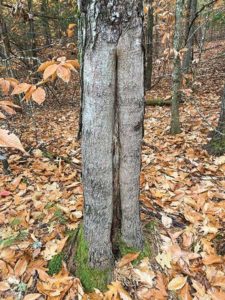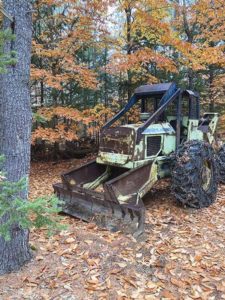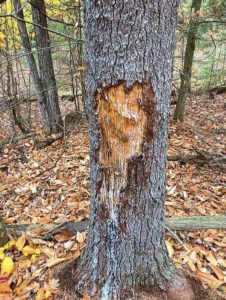 |
| Heavy damage done to a red oak during harvest (conducted by a different owner). The entire butt log is ruined, and decay likely extends higher than shown here. |
 |
| 1988 Tree Farmer C5D – a mid-sized cable skidder |
 |
| The pine tree discussed here, eight months after being damaged. |
By Noah Gleason-Hart
Photos by the author
Low-impact forestry’s guiding principle is that the main product of any harvest is not what is cut, but instead the quality of the forest that is left behind. Part of abiding by that principle is marking the right trees to harvest; if you primarily cut the lowest-quality trees in your forest, you’ll continuously improve stand quality. However, all your efforts are for naught if you don’t protect your high-quality trees from damage as you skid or forward out harvested wood. A tell-tale sign of a poorly conducted harvest is many standing trees with bark damage at their bottoms – often colloquially called “skidder blight” because the damage occurs when skidders hit standing trees or when logs rub against trees as they’re skidded out.
The aesthetic impact of this type of damage is clear – no one wants to walk through a forest of debarked trees – but what are the ecological and financial costs? Let’s zoom in on a single white pine I damaged last winter while cutting on my partner’s family farm in York County.
The Backstory
The goal of the harvest was to remove pockets of diseased beech to make room for healthier trees. I cut with a chainsaw and used a cable skidder to pull trees for firewood. The skidder I was running – a Tree Farmer C5D – is small by the standards of modern forestry equipment, but it’s still 8 ½ feet wide. To do good quality work, I practiced many of the techniques I’ve learned at MOFGA’s Low-Impact Forestry (LIF) workshops. I timed the harvest for the winter when the bark is firmly attached. I directionally felled trees to avoid hitting young trees, and I pulled cable rather than backing up to every tree to reduce the size of the trail network. I also set up my trails to minimize sharp corners and designated trees I planned to cut later in the harvest as bumpers, if necessary.
However, on one of the last days of the harvest, I misjudged a turn while backing down a narrow skid trail and hit a large Eastern white pine. Skidders are articulated in the middle and, if you’re not careful, you can get a tree stuck between your front and back tires. I was not careful and in the process of extricating the skidder, I tore off a significant chunk of bark from the pine.
The Tree
The pine I hit was 15 inches in diameter at breast height (15-inch DBH) with a healthy crown and a straight trunk; exactly the kind of high-quality, small sawtimber-sized crop tree that I would like to grow for the future.
In the book “Low-Impact Forestry,” author Mitch Lanksy describes William Ostrofsky’s stand damage assessment criteria, which divides damage into “light,” “moderate,” and “severe.” I removed a 9-by-28-inch bark chunk – around a quarter of the tree’s diameter – so Ostrofsky would categorize the damage as severe and likely to cause a significant reduction in growth and probable mortality soon.
You could leave the tree as a future home for wildlife, but if you decided to harvest it now and salvage its financial value, what would it be worth? My assessment of the standing tree is that it has two 16-foot sawlogs in it. Using the log table on a Biltmore stick, I can calculate that a 15-inch DBH tree with two sawlogs contains 155 board feet of lumber. You could sell the rest of the tree down to a 4-inch top for pulp, but those markets are poor at the moment, and the vast majority of a tree’s value is in the butt, so we’ll only count sawlog value for this exercise.
Delivered to the mill, quality pine sawlogs sold without being sorted by grade – often called “woods run” – bring about $350 per thousand board feet (MBF), or 35 cents per board foot. So this tree is worth $54.25 (155 board feet x $0.35) at the mill. If you cut and sold this log yourself, you would keep all this – minus the trucking cost to the mill, the cost of production and the cost of owning the land.
What if you hired a logger to conduct the harvest? There are lots of ways to compensate loggers – from an hourly rate to a flat rate per thousand board feet – but let’s assume that you, your forester and your logger have chosen a stumpage rate: The logger buys the rights to cut your trees and pays you a portion of the price they receive at the mill, called stumpage. The Maine Forest Service publishes a stumpage report by county and the most recent report from 2018 shows average stumpage prices for Eastern white pine sawlogs in York County at $176 MBF. This equals 17.6 cents per board foot, so you would receive $27.28 (155 MBF x $0.176) from your logger.
What if I had not hit the tree and instead grew it to 22-inch DBH before deciding to cut it? With the two 16-foot logs this size tree would yield, we’d have 370 board feet worth $129.50, if you cut it yourself, or $65 in stumpage. This is a conservative projection of this tree’s board feet at 22 inches in diameter. As the tree grows, some of the straight upper wood, currently too small for the mill, will likely grow large enough to yield sawlogs; your total board feet in the tree could be significantly higher.
What if this tree made it to 30 inches without blowing over, getting red rot or being hit during a subsequent harvesting operation? Then the tree could yield 720 board feet worth $252 in total value, or $126.72 in stumpage – more than quadruple what it was worth at 15 inches!
In addition to the financial cost, there’s the equally important, but harder to quantify, ecological cost of damaged trees. The growth rate and general health of the tree I damaged will decline significantly. From a climate mitigation perspective, the carbon sequestration rate will slow as the tree begins to stagnate; it will take in less carbon. The tree will still store carbon, but we’ll have missed an opportunity to grow a large-diameter, high carbon value tree. Unhealthy trees may also produce fewer seeds; from a regeneration perspective, a damaged tree will not contribute to the composition of your next forest.
Takeaway
The takeaway is not necessarily that a cable skidder is the wrong tool to carry out a conscientious harvest. There are plenty of loggers doing good work in the woods with cable skidders. The problem was operator error – plain and simple.
Recognize that, regardless of the equipment you use or hire, you must take every measure to avoid residual damage. If you are doing the work yourself, this may mean seeking out training and slowing your pace. If you are hiring a forester and logger, find professionals who are committed to exceptional post-harvest results. Careful logging is time-consuming. Many current payment structures incentivize production, so they may not adequately compensate loggers for outstanding work in all circumstances. If residual stand quality is important to you, you may need to consider alternative payment structures that allow conscientious loggers to do careful work while making a living. Careful logging pays off over the long term.
For more information about techniques to minimize residual damage while logging, systems for paying loggers and William Ostrofsky’s stand damage assessment technique, see Mitch Lansky’s “Low-Impact Forestry” (available as a free download on the Low-Impact Forestry page of MOFGA’s website).
Noah Gleason-Hart is MOFGA’s low-impact forestry specialist. You can contact him at [email protected].
